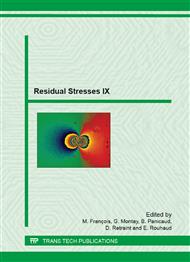[1]
V. Schulze, Modern Mechanical Surface Treatment, Wiley-VCH, Weinheim, (2006).
Google Scholar
[2]
T.E. Davidson, C.S. Barton, A.N. Reiner, D.P. Kendall, New Approach to the Autofrettage of High-Strength Cylinders, Experimental Mechanics 2/2 (1962) pp.33-40.
DOI: 10.1007/bf02325691
Google Scholar
[3]
T. Seeger, M. Schön, J.W. Bergmann, M. Vormwald, Autofrettage I – Dauerfestigkeits-steigerung durch Autofrettage, Forschungsvereinigung Verbrennungskraftmaschinen e.V., (1993).
Google Scholar
[4]
E. Brinksmeier, J.T. Cammet, W. König, P. Leskovar, J. Peters, H.K. Tönshoff, Residual stresses: measurement and causes in machining processes, Annals of the CIRP 31/2 (1982) 491-509.
DOI: 10.1016/s0007-8506(07)60172-3
Google Scholar
[5]
H. Brünnet, I. Yi, D. Bähre, Modeling of residual stresses and shape deviations along the process chain of Autofrettaged components, Journal of Materials Science and Engineering A 1/7A (2011) pp.915-936.
DOI: 10.4028/www.scientific.net/msf.768-769.79
Google Scholar
[6]
H. Brünnet, D. Bähre, Simulation of Beneficial Compressive Residual Stress Fields as Design Tool in Manufacturing Internally Pressurized Parts, Proceedings of Simulia Community Conference, Conference eBook, 2013, pp.1273-1315.
Google Scholar
[7]
P.S. Prevey, Finite Element Correction for Stress Relaxation in Complex Geometries, Lambda Research Diffraction Notes 17, Lambda Research Cincinatti, USA, (1996).
Google Scholar
[8]
M. Lechmann, Development of a Fatigue Fracture Design Concept for Internal Pressure Loaded Parts with Extensive Compressive Stress Fields, Dissertation, Stuttgart University, Germany, (2008).
Google Scholar
[9]
H. Brünnet, D. Bähre, Modeling of the Influence of Sample Preparation Sequences When Measuring Selectively Induced Residual Stress Depth Profiles, J Manuf Process 15 (2013) pp.572-579.
DOI: 10.1016/j.jmapro.2013.06.009
Google Scholar
[10]
H. Brünnet, D. Bähre, T. Rickert, D. Dapprich, Modeling and Measurement of Residual Stresses Along the Process Chain of Autofrettaged Components by using FEA and Hole-Drilling Method with ESPI, Material Science Forum 768-769 (2014) pp.79-86.
DOI: 10.4028/www.scientific.net/msf.768-769.79
Google Scholar
[11]
M.T. Hutchings, P.J. Withers, T.M. Holden, T. Lorentzen, Introduction to the Characterization of Residual Stress by Neutron Diffraction, Taylor & Francis, London, (2005).
DOI: 10.1201/9780203402818
Google Scholar
[12]
B. Eigenmann, E. Macherauch, X-Ray Investigation of Stress States in Materials – Part III, Material Science and Engineering Technology 27/9 (1996) pp.426-437.
Google Scholar
[13]
X.P. Huang, A general autofrettage model of a thick-walled cylinder based on tensile-compressive stress-strain curve of a material, J. Strain Analysis 40/6 (2005) pp.599-607.
DOI: 10.1243/030932405x16070
Google Scholar
[14]
J.R. Kornmeier, J. Saroun, J. Gibmeier, M. Hofmann, Neutron Residual Strain Surface Scans – Experimental Results and Monte Carlo Simulations, Materials Science Forum 768-769 (2014) pp.52-59.
DOI: 10.4028/www.scientific.net/msf.768-769.52
Google Scholar


